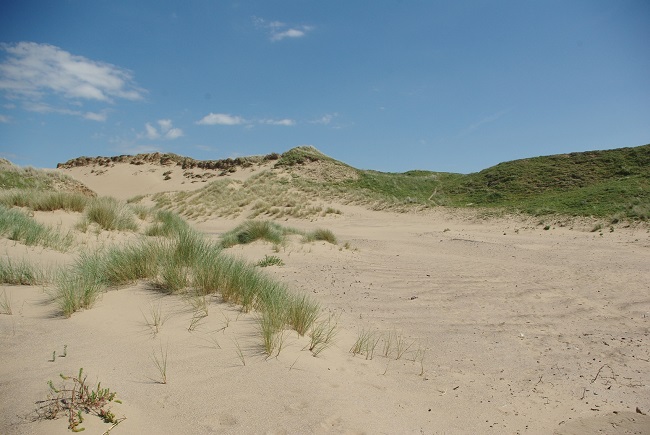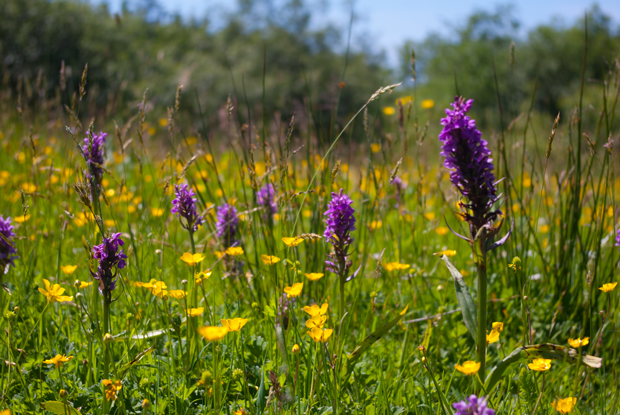Nature in Bridgend
Bridgend County Borough's mosaic of habitats includes ancient woodlands, unimproved wet grasslands, chalk grassland, river valleys and rocky gorges, coastal sand dunes and saltmarsh. These habitats support an exceptionally varied flora and fauna, including many rare and declining species. The county borough contains three European designated Special Area of Conservation (Cefn Cribwr Grasslands, Blackmill woodlands and Kenfig SACs). Other notable designations include two National Nature Reserves (NNRs) at Kenfig to the west of Porthcawl and Merthyr Mawr NNR. Both of these sites were once part of a huge dune system, which once stretched along the coast from the River Ogmore to the Gower peninsula. Kenfig Pool, the largest freshwater lake in south Wales, lies at the heart of the reserve and is particularly valuable as a stopping off point for migrating birds.

About

Our Aims

How are we going to achieve it?
We are producing an updated Bridgend Nature Recovery Action plan in line with the broader aims of the Wales Nature Recovery Action plan. This plan will help establish a framework within which partners will work to hit national targets relating to issues such as habitat protection and management.
We are putting particular emphasis on ensuring connectivity between habitats throughout the county. We aim to create a network of abundant habitats with viable connected corridors to ensure local resilient ecosystems.
Partners of the Bridgend LNP monitor, report, and strategize on local biodiversity issues through regular correspondence at meetings and via newsletters. We arrange talks in schools and colleges to engage younger people in nature conservation.
As well as the co-ordination, monitoring and strategizing outlined above, the partnership engages in a wide range of applied conservation measures. We erect nesting boxes for birds, bugs and bats, map and monitor invasive species, and write up and carry out sustainable management schemes. We plan bulbs and seeds of native flower species at appropriate times in appropriate areas for biodiversity enhancement and visual enrichment and generally carry out a wide range of work in line with the ecological calendar.
The partnership also provides an opportunity for individuals, community groups and third sector organisation to access government funding for nature-recovery projects.
Join the Bridgend Local Nature Partnership!
Take Action
You can help by applying responsible ecological principles in your own life. A good place to start is in the garden. There are several resources on gardening for biodiversity enhancement. For instance, No Mow May is a popular and easy initiative you might like to start with in order to help local wildlife. Generally, maintaining a garden of native vegetation with high species richness is a good way to make a positive impact. Other actions that have clear positive impacts include recycling, nest box erecting and minimal pesticide use.
Educate
The first step towards helping nature is often learning more about it, so finding this page is a great first step. Bridgend LNP regularly organises and promotes talks and workshops on effective nature action by its partners. Attending such talks or sharing your own knowledge is another way in which you can make a positive impact.
Nature is all around us and can be appreciated in all its guises. However, there are some areas within the county that are home to particularly significant habitats and species richness and thus of particular importance to wildlife. The following are just a number of the sites which are open to the public and provide a place to enjoy nature within Bridgend county borough:
Ogmore Washeries is home to several rare colliery spoil invertebrate species, such as the ghost slug and various rare millipede species’. The brown-banded carder bee (Bombus humilis) has also been recorded at the site. The site also provides an important habitat for bullfinches (Pyrrhula pyrrhula) and horseshoe bats (Rhinolophus). The site also serves as testament of the value of the LNP, having secured funding through Local Places for Nature in 2020.
Kenfig Burrows National Nature Reserve comprises a massive dune system and Kenfig Pool, which is the largest natural body of freshwater in South Wales. It is one of the few sites in Europe where one can see the endangered fen orchid (Liparis loeselii). It is also one of the only places in the UK that the bittern (Botaurus stellaris) can be seen during the winter. Golden Plovers, Tufted Ducks and Pochards can all be spotted from the bird hides overlooking the pool.
Merthyr Mawr Warren National Nature Reserve is home to the highest dune in all of Wales, and the second highest in Europe, known as the Big Dipper. The combination of ancient limestone cliffs and sand coverage to create a unique geological substrate that supports a wealth of unusual plants, insects and fungi. Rare orchids such as marsh helleborine (Epipactis palustris), interesting Morels and Helvellas fungi and threatened invertebrates such as the cuckoo bee (Coelioxys mandibularis) can all be found at this site.
Parc Slip Nature Reserve is comprised of a mosaic of diverse habitat including grassland, woodland, wetlands and freshwater lakes. Tawny owls (Strix aluco), wood mouse (Apodemus sylvaticus), green woodpecker (Picus viridis), lapwing (Vanellinae) and water rail (Rallus aquaticus) have all been spotted at this site. Parc Slip also has good amphibian assemblages including great crested newt (Triturus cristatus). In the summer, oxeye daisy (Leucanthemum vulgare), red bartsia (Odontites vernus) and a variety of wild orchids can be spotted in the fields around the visitor centre.
Bryngarw Country Park is a 100-acre estate adjacent to the resplendent Bryngarw House. Consisting of mature broadleaf woodland, grassland, wildflower meadows and ponds, this park punches well above its weight in terms of species diversity. Woodpeckers and foxes can be spotted in the woodland, whilst the pond plays host to palmate newts (Lissotriton helveticus) and common toad (Bufo bufo). Being a Country Park, Bryngarw provides a great opportunity for families to engage with nature and provides links to the Garw Valley along the community route.
Locks Common Local Nature Reserve (LNR) is one of six LNRS within the county borough. The common is also a Regionally Important Geological Site as it contains two hectares of limestone pavement. This unusual geological substrate supports a specific and varied plant species assemblage including species such as squinancywort (Asperula cynanchica), wild thyme (Thymus polytrichus) and eyebright (Euphrasia sp.). The common also includes neutral grasslands, scrub and sub maritime heath features.The sub maritime heath is a rare habitat and generally only found on the western seaboard of the Atlantic Ocean. Given its coastal location, on a clear day there are splendid views of Swansea and Devon.
Highlights
Grey seals (Halichoerus grypus), harbour porpoise (Phocoena phocoena) and common dolphins (Delphinus delphis) can sometimes be spotted in the sea around Porthcawl. Keep an eye out whilst walking along the promenade.
Adder (Vipera berus), grass snake (Natrix natrix) and a wide range of interesting wetland plants including cranberry (Vaccinium oxycoccos), bogbean (Menyanthes) and remote sedge (Carex remota) have been noted in the wetter areas around the Ogmore Valley.
Marshy grasslands around Cwn Risca support a population of the nationally important marsh fritillary (Euphydryas aurinia). Keep an eye out also for its main foodplant the Devil’s-bit-scabious (Succisa pratensis).
The beautiful marsh helleborine orchid (Epipactis palustris) can be spotted flowering at Merthyr Mawr in the summer. At the same site, fungi lovers should keep an eye out for the distinctive Morel, which fruits from March to June.
Woodlands around the LLynfi valley floor contain notable butterfly species such as the green-veined white (Pieris napi) and speckled wood butterflies (Pararge aegeria), as well as some significant ferns such as the lemon-scented fern (Oreopteris limbosperma) and hart’s-tongue fern (Asplenium scolopendrium).
The Llynfi and Garw upland areas are a good location for spotting peregrine falcons (Falco peregrinus), red kites ( Milvus milvus), nightjar (Caprimulgus europaeus) and goshawks (Accipiter gentilis) and a variety of bat species.
The River Garw, which runs North to South through the North of the county provides a regular habitat for kingfishers (Alcedo atthis) and Daubenton’s bats (Myotis daubentoniid). Similarly, the Ewenny River on the eastern boundary of the county borough also support a range of species including wild brown trout (Salmo trutta) and grayling (Thymallus thymallus).
The highly elusive ghost slug (Selenochlams ysbryda), which was only recorded as a species in 2008, has been found at the Ogmore Washeries. Amateur entomologists can find a wide range of interesting and unusual invertebrates at the site.
Pipistrelle bats (Pipistrellus sp.) can be spotted, alongside northern lapwings (Vanellus vanellus) and willow warblers (Phylloscopus trochilus) around the grasslands of Bettws.
Finally, keep an eye out for the ‘Nature Keeper’ oak sculptures dotted around the green spaces of Bridgend. 5 are at Bryngarw country park, and another 5 are dotted around the county’s protected sites.
Key contact
Sam Bowler - Local Nature Partnership Co-ordinator
Bridgend County Borough Council
Civic Offices, Angel Street
Bridgend
CF31 4WB
Email: [email protected]
Website: link to follow
Bridgend is a valued member of the all-Wales Local Nature Partnership Network















